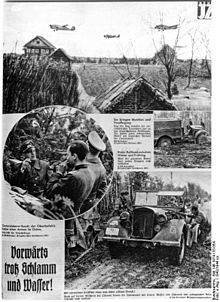Illustrated
An Illustrierte (short for Illustrierte Zeitschrift ) is a periodically published general-interest magazine with a particularly large number of pictures. Heavily illustrated magazines, especially the “ Rainbow Press ”, often tend towards tabloid journalism . Since printing pictures used to be more complex and required more expensive paper, some magazines specialized in picture-intensive topics and journalistic styles. Other magazines and especially newspapers were illustrated rather sparsely. As the printing of pictures became easier over time, the magazines lost their unique position and meaning.
Features and properties
Illustrated are issued usually weekly, semi-monthly, monthly or quarterly, so in very different periodicities . They are often printed in color and on coated paper, and now also on glossy paper for the newer titles. To a large extent, they are commercial newspapers that are sold in retail outlets and at kiosks .
Magazines contain articles on topics of general interest, are written in easy to understand language, and are intended for entertainment purposes. Topics are different depending on the title, and the level of the individual titles varies a lot. In addition to current political and social issues, scandal stories, reports about the noble houses and celebrities, as well as sex and crime are discussed.
History and Development
Illustrations of leaves have been known since the 15th century ; these mockery pamphlets and information sheets were often illustrated with woodcuts . The illustration of the daily press began in Europe at the end of the 18th century ; Copper engravings were mainly used here . The formative development at the time came through fashion magazines such as Le cabinet des modes (1785–1792) or Le Journal des dames et des modes (1797–1839).
Following the example of the Illustrated London News and L'Illustration (Paris), the Illustrirte Zeitung appeared from July 1, 1843 .
Technical inventions such as the high-speed press , the thread sewing machine , the autotype , new paper-making processes and, above all, the large-scale implementation of photography , the improvements in photo technology and the possibility of remote transmission of images made it possible to differentiate from the forerunners of the magazine format from the middle of the 19th century . The magazine market developed into a mass market.
The photojournalism was the beginning of the 20th century ; Classics in the magazine industry at that time were the Berliner Illustrirte Zeitung and the Arbeiter Illustrierte Zeitung (AIZ), they achieved such high print runs of 500,000 copies each. In 1930, the total weekly circulation of the magazines in Germany was around 5 million copies, and the range is said to have even reached 20 million readers.
In the 1960s, the Bauer publishing group dominated the magazine market in Germany, but for several decades it has been facing competition from the publishers Axel Springer , Burda and Gruner + Jahr .
Popular magazines
A selection broken down by country:
Germany:
- Brigitte (since 1886)
- BUNTE (since 1954)
- Constanze (1948–1969)
- Film and Woman (1948–1969)
- Gala (since 1994)
- New Illustrated Magazine (1946–1966)
- Quick (1948-1992)
- (New) revue (1946–2008)
- star (since 1948)
- SUPERillu (since 1990)
- Worldview (1946–1961)
Austria:
Switzerland:
- annabelle (since 1938)
- Glückspost (since 1884)
- Schweizer Illustrierte (since 1911)
France:
- Excelsior (c. 1910)
- Femina (c. 1903)
- Musica (c. 1902)
- Paris Match (since 1949)
- VU (1928–1940)
UNITED STATES:
literature
- Anton Holzer: Frenzied reporters. A cultural history of photojournalism . Primus, Darmstadt 2014, ISBN 978-3-86312-073-3 .
- Pierre Albert, Gilles Feyel: Photography and Media. The changes in the illustrated press. In: Michel Frizot (ed.): New history of photography. Könemann, Cologne 1998, ISBN 3-8290-1327-2 , pp. 358-369.
- Ernst Fischer , Wilhelm Haefs, York-Gothart Mix (Hrsg.): From Almanach to Newspaper. A handbook of the media in Germany 1700–1800. CH Beck, Munich 1999, ISBN 3-406-45476-3 .
- Horst Holzer : Illustrated and Society. On the political content of Quick, Revue and Stern. Rombach, Freiburg (Breisgau) 1967.
- Wolfgang Weber: Johann Jakob Weber . The founder of the illustrated press in Germany. Lehmstedt, Leipzig 2003, ISBN 3-937146-03-2 .
Web links
- Literature on the subject of illustrated magazines in the catalog of the German National Library

